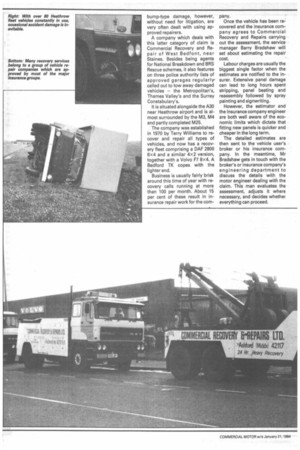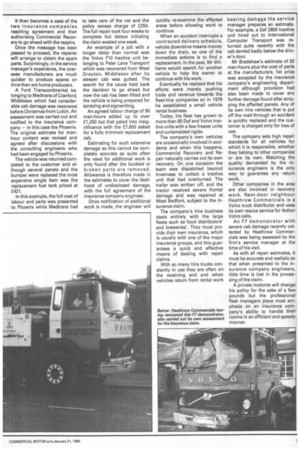Assessing the damage a specialist's art
Page 33

Page 34

Page 35

If you've noticed an error in this article please click here to report it so we can fix it.
WHEN A TRAFFIC accident occurs, the operator or transport manager is faced with some pressing problems. One is the need to have the vehicle recovered without causing further damage, another is how to maintain his delivery schedules.
A large company can usually find a replacement but the majority of operators do not have the spare capacity.
Fleet hire companies compete fiercely to help transport managers stuck with this problem, but despite competitive hire rates, an operator with a vehicle off the road is losing revenue fast so there is a real need id' prompt insurance action coupled with speedy repairs.
Major insurance companies have their own highly qualifiec and experienced staff engineers who are responsible for examin ing and co-ordinating all th( claims.
Straightforward cases o continued overleaf bump-type damage, however, without need for litigation, are very often dealt with using approved repairers.
A company which deals with this latter category of claim is Commercial Recovery and Repair of West Bedfont, near Staines. Besides being agents for National Breakdown and BRS Rescue schemes, it also features on three police authority lists of approved garages regularlycalled out to tow away damaged vehicles — the Metropolitan's, Thames Valley's and the Surrey Constabulary's.
It is situated alongside the A30 near Heathrow airport and is almost surrounded by the M3, M4 and partly completed M25.
The company was established in 1970 by Terry Williams to recover and repair all types of vehicles, and now has a recovery fleet comprising a DAF 2800 6x4 and a similar 4x2 version, together with a Volvo F7 8x4. A Bedford TK copes with the lighter end.
Business is usually fairly brisk around this time of year with recovery calls running at more than 100 per month. About 15 per cent of these result in insurance repair work for the corn pany.
Once the vehicle has been recovered and the insurance company agrees to Commercial Recovery and Repairs carrying out the assessment, the service manager Barry Bradshaw will set about estimating the repair cost.
Labour charges are usually the biggest single factor when the estimates are notified to the insurer. Extensive panel damage can lead to long hours spent stripping, panel beating and reassembly followed by spray painting and signwriting.
However, the estimator and the insurance company engineer are both well aware of the economic limits which dictate that fitting new panels is quicker and cheaper in the long term.
The detailed estimates are then sent to the vehicle user's broker or his insurance company. In the meantime, Mr Bradshaw gets in touch with the broker's or insurance company's engineering department to discuss the details with . the motor engineer dealing with the claim. This man evaluates the assessment, adjusts it where necessary, and decides whether everything can proceed. It then becomes a case of the two insurance companies reaching agreement and then authorising Commercial Recovery to go ahead with the repairs.
Once the message has been passed to proceed, the repairer will arrange to obtain the spare parts. Surprisingly, in the service manager's experience, the overseas manufacturers are much quicker to produce spares on time than are home producers.
A Ford Transcontinental belonging to Medtrans of Cranford, Middlesex which had considerable cab damage was recovered before Christmas from Luton. An assessment was carried out and notified to the insurance company — in this case the Phoenix. The original estimate for manhour content was revised and agreed after discussions with the consulting engineers who had been engaged by Phoenix.
The vehicle was returned completed to the customer and although several panels and the bumper were replaced the most expensive single item was the replacement fuel tank priced at £421.
In this example, the full cost of labour and parts was presented to Phoenix while Medtrans had to take care of the vat and the policy excess charge of £250. The full repair took four weeks to complete but delays initiating the claim wasted one week.
An example of a job with a longer delay than normal was the Volvo F10 tractive unit belonging to Peter Lane Transport which was recovered from West Drayton, Middlesex after its sleeper cab was gutted. The search for the cause held back the decision to go ahead but now the cab has been fitted and the vehicle is being prepared for spraying and signwriting.
An agreed labour charge of 90 man-hours added up to over £1,250 but that paled into insignificance with the £7,600 asked for a fully trimmed replacement cab.
Estimating for such extensive damage as this cannot be completely accurate as quite often the need for additional work is only found after the buckled or broken parts are removed. Allowance is therefore made in the estimates to cover the likelihood of undisclosed damage, with the full agreement of the insurance company engineer.
Once notification of additional work is made, the engineer wil quickly re-examine the affected areas before allowing work to continue.
When an accident interrupts a contracted delivery schedule, vehicle downtime means money down the drain, so one of the immediate actions is to find a replacement. In the past, Mr Williams would search for another vehicle to help the owner to continue with his work.
Eventually he realised that his efforts were merely pushing trade and revenue towards the fleet-hire companies so in 1979 he established a small vehicle rental business.
Today, his fleet has grown to more than 80 Daf and Volvo tractive units with a few freezer units and curtainsided rigids.
The company's own vehicles are occasionally involved in accidents and when this happens, Commercial Recovery and Repair naturally carries out its own recovery. On one occasion the team was dispatched beyond Inverness to collect a tractive unit that had overturned. The trailer was written off, and the tractor received severe frontal damage and was repaired at West Bedfont, subject to the insurance claim.
The company's hire business deals entirely with the large fleets such as food distributors' and breweries'. They must provide their own insurance, which is usually with one of the major insurance groups, and this guarantees a quick and effective means of dealing with repair claims.
With so many hire trucks constantly in use they are often on the receiving end and when vehicles return from rental work bearing damage the service manager prepares an estimate. For example, a Daf 2800 tractive unit hired out to International .Computer Transport was returned quite recently with the cab dented badly below the driver's door.
Mr Bradshaw's estimate of 32 man-hours plus the cost of parts at the manufacturers, list price was accepted by the insurance company's engineering department although provision had also been made to cover any further damage found after stripping the affected panels. Any of its own hire vehicles that is put off the road through an accident is quickly replaced and the customer is charged only for loss of use.
The company sets high repair standards for all vehicles for which it is responsible, whether they belong to other companies or are its own. Matching the quality demanded by the insurance engineers is the only way to guarantee any return work.
Other companies in the area are also involved in recovery work. Next-door neighbour Heathrow Commercials is a Volvo truck distributor and uses its own rescue service for Action Volvo calls.
An F7 demonstrator with severe cab damage recently collected by Heathrow Commercials was being assessed by the firm's service manager at the time of his visit.
As with all repair estimates, it must be accurate and realistic so that when presented to the insurance company engineers, little time is lost in the processing of the claim.
A private motorist will change his policy for the sake of a few pounds but the professional fleet managers place most emphasis on an insurance company's ability to handle their claims in an efficient and speedy manner.
















































































